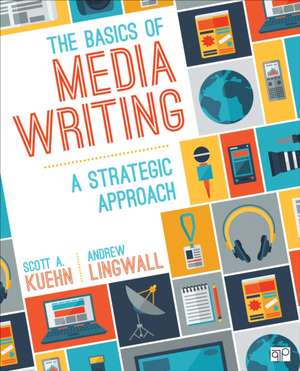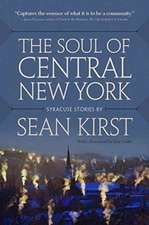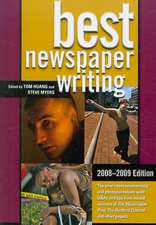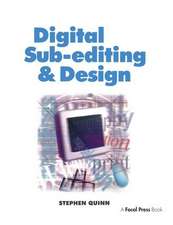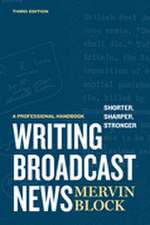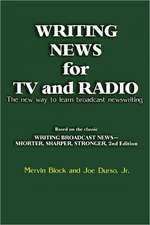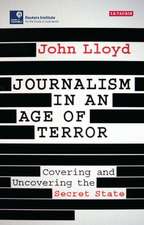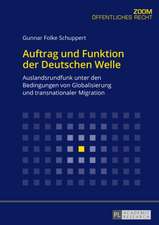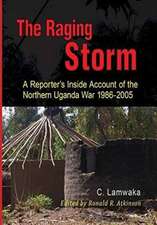The Basics of Media Writing: A Strategic Approach
Autor Scott A. Kuehn, James Andrew Lingwallen Limba Engleză Paperback – mar 2017
Preț: 697.39 lei
Preț vechi: 942.42 lei
-26% Nou
133.45€ • 139.68$ • 111.07£
Carte disponibilă
Livrare economică 10-24 martie
Livrare express 22-28 februarie pentru 41.14 lei
Specificații
ISBN-10: 1506308104
Pagini: 568
Dimensiuni: 187 x 232 x 20 mm
Greutate: 0.84 kg
Ediția:Revised
Editura: SAGE Publications
Colecția CQ Press
Locul publicării:Washington DC, United States
Recenzii
Cuprins
ACKNOWLEDGMENTS
ABOUT THE AUTHORS
SECTION I: MEDIA WRITING FOUNDATIONS
CHAPTER 1: YOU AS A WRITER
Welcome to Media Writing!
Media Consumption and Production, All at Once
Media Responsibilities and Challenges
The Role of Skilled Writing
Understanding Yourself as a Writer
The Media Writer’s Self-Perception (MWSP) Scale
The Grammar, Spelling, Punctuation (GSP) Test
Summary
Key Terms
Discussion Questions
Chapter Exercises
Additional Resources
CHAPTER 2: MEDIA WRITING PROFESSIONS AND STRATEGIES
21st-Century Media: A Rapidly Changing Landscape
Overview of the Major Media Professions
Professional Media Writing Strategy
Using the FAJA Points in Your Writing
Summary
Key Terms
Discussion Questions
Chapter Exercises
Additional Resources
CHAPTER 3: MEDIA WRITING STYLE AND LANGUAGE CONVENTIONS
Style: Your Audiences Are Counting on It
Media Writing Style Conventions
The Connection Between Thinking and Writing
Style Guides
Selected Points of AP Style
Additional Language Rules
Grammar, Spelling, and Punctuation
Summary
Key Terms
Discussion Questions
Chapter Exercises
Additional Resources
SECTION II: NEWS SETTINGS
CHAPTER 4: REPORTING AND INTERVIEWING
Journalism: A Higher Calling
The First Amendment Guarantee
Professional News Writing Standards
The Converged Media Environment
Applying the Professional Strategy Triangle to Reporting
News Reporting
Interviewing
Summary
Key Terms
Discussion Questions
Chapter Exercises
Additional Resources
CHAPTER 5: HARD NEWS AND FEATURE WRITING
Versatility Is the Key
The Multiplatform Story
Writing the Hard News Story
Using Quotations
Writing the Feature Story
Summary
Key Terms
Discussion Questions
Chapter Exercises
Additional Resources
CHAPTER 6: ELECTRONIC NEWS WRITING: RADIO AND TELEVISION
The Electronic Media Professions
What Do Broadcast Journalists Do?
The Professional Strategy Triangle for Broadcast News
Actualities and Sound Bites: Sound on Tape
Television News Copy
Promotional and Housekeeping Copy
Summary
Key Terms
Discussion Questions
Chapter Exercises
Additional Resources
CHAPTER 7: COPYEDITING
Copy Editors: The Critical Link
Overview of the Copyediting Profession
Copyediting in News and Public Relations Settings
Copyediting in the Digital Environment
Copyediting Techniques
Summary
Key Terms
Discussion Questions
Chapter Exercises
Additional Resources
CHAPTER 8: MEDIA LAW AND ETHICS
Media Law and Ethics Work Together
The Fundamental Freedoms of the First Amendment
Libel: Damage to Reputation Through False Content
Privacy Law
Copyright and the Law of Intellectual Property
Access to Government Information and Government Meetings
Ethics in the Media
Special Considerations for Public Relations and Advertising
Other Approaches to Ethical Decision-Making
Summary
Key Terms
Discussion Questions
Chapter Exercises
Additional Resources
SECTION III: DIGITAL SETTINGS
CHAPTER 9: WRITING FOR SOCIAL MEDIA
It’s Both Personal and Professional
The Media Industry and Social Media
Planning Social Media Campaigns
Social Media Copywriting
Key Style Elements for Social Media Copy
Social Media Copywriting: Length Matters
Summary
Key Terms
Discussion Questions
Chapter Exercises
Additional Resources
CHAPTER 10: WEB COPYWRITING
The Omnipresent World Wide Web
Web Copywriting
Middle-Form Web Copy: Style
Long-Form Web Copy: Blogs
Summary
Key Terms
Discussion Questions
Chapter Exercises
Additional Resources
SECTION IV: PERSUASIVE SETTINGS
CHAPTER 11: BASIC PERSUASIVE WRITING
Persuasion: A Timeless Skill
Key Persuasion Theories
Persuasion, Ethics, and Professionalism
Using the FAJA Points for Persuasion
Example 1: Using Judgment for Public Relations Writing
Example 2: Using Action for Advertising Writing
Putting Persuasion Topic Points to Work
Moving Audiences to Action With Motive Appeals
Summary
Key Terms
Discussion Questions
Chapter Exercises
Additional Resources
CHAPTER 12: PUBLIC RELATIONS
Public Relations Is Everywhere
The Three Types of Media: Paid, Earned, and Owned
Uncontrolled and Controlled Media
Professional Media Writing Strategy
Public Relations Writing Tools
Summary
Key Terms
Discussion Questions
Chapter Exercises
Additional Resources
CHAPTER 13: ADVERTISING
Advertising: A Timeless Enterprise
The Advertising Profession
The Art and Science of Copywriting
Writing the Print Advertisement
Writing the Online Advertisement
Writing the Radio Commercial
Writing the Television Commercial
Summary
Key Terms
Discussion Questions
Chapter Exercises
Additional Resources
CHAPTER 14: BUSINESS COMMUNICATION
Business Communication: Anything but Boring!
The Corporate Communication Profession
Business Communication Flows Four Ways
Using the Professional Strategy Triangle for Business Communication
Summary
Key Terms
Discussion Questions
Chapter Exercises
Additional Resources
APPENDIX: MEDIA WRITER’S SELF-PERCEPTION SCALE
NOTES
INDEX
Notă biografică
Scott Kuehn, Ph.D. - is Professor of Communication at Clarion University of Pennsylvania. He earned his Ph.D. in Speech Communication at the Pennsylvania State University in 1987. Scott teaches courses in mass communication research, communication law, new media effects, social media for media professions, mass media criticism, and photography. His research focuses on the perceptions of communication skills and communication competence, has been published in Journalism and Mass Communication Educator and Communication Education. He currently serves as advisor for WCUC 91.7 FM, Clarion University¿s 3800 watt radio station. Scott is an amatuer photographer with expertise in medium and large format film photography. Scott is also a part time musician who records jingles and other radio, television, and cinematic music.
